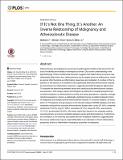| dc.contributor.author | Li, Matthew | |
| dc.contributor.author | Milner, Danny A. | |
| dc.contributor.author | Cima, Michael J. | |
| dc.date.accessioned | 2015-08-20T18:10:36Z | |
| dc.date.available | 2015-08-20T18:10:36Z | |
| dc.date.issued | 2015-05 | |
| dc.date.submitted | 2014-02 | |
| dc.identifier.issn | 1932-6203 | |
| dc.identifier.uri | http://hdl.handle.net/1721.1/98133 | |
| dc.description.abstract | Atherosclerosis and malignancy are pervasive pathological conditions that account for the bulk of morbidity and mortality in developed countries. Our current understanding of the patholobiology of these fundamental disorders suggests that inflammatory processes may differentially affect them; thus, atherosclerosis can be largely driven by inflammation, where as cancer often flourishes as inflammatory responses are modulated. A corollary of this hypothesis is that cancer (or its treatment may significantly attenuate atherosclerotic disease by diminishing host inflammatory response, suggesting potential therapeutic approaches. To evaluate the relationship between cancer and cardiovascular atherosclerotic disease, we assessed 1,024 autopsy reports from Brigham and Women’s Hospital and performed correlative analyses on atherosclerotic severity and cancer prevalence. In gender- and age-matched populations, there is a statistically significant inverse correlation between history of malignancy and autopsy-proven atherosclerotic disease. In a second analysis, we evaluated 147,779 patients through analysis of the Harvard Catalyst SHRINE database and demonstrated a reduced non-coronary atherosclerotic disease rate: control (27.40%), leukemia/lymphoma (12.57%), lung (17.63%), colorectal (18.17%), breast (9.79%), uterus/cervix (11.47%), and prostate (18.40%). We herein report that, based on two separate medical records analysis, an inverse correlation between cancer and atherosclerosis. Furthermore, this correlation is not uniformly associated with anti-neoplastic treatment, suggesting that the inverse relationship may be in part attributable to an individual’s intrinsic inflammatory propensity, and/or to inflammation-modulatory properties of neoplasms. | en_US |
| dc.description.sponsorship | Harvard University (Shared Health Research Information Network Prize) | en_US |
| dc.language.iso | en_US | |
| dc.publisher | Public Library of Science | en_US |
| dc.relation.isversionof | http://dx.doi.org/10.1371/journal.pone.0126855 | en_US |
| dc.rights | Creative Commons Attribution | en_US |
| dc.rights.uri | http://creativecommons.org/licenses/by/4.0/ | en_US |
| dc.source | Public Library of Science | en_US |
| dc.title | If It’s Not One Thing, It’s Another: An Inverse Relationship of Malignancy and Atherosclerotic Disease | en_US |
| dc.type | Article | en_US |
| dc.identifier.citation | Li, Matthew, Michael J Cima, and Danny A. Milner. “If It’s Not One Thing, It’s Another: An Inverse Relationship of Malignancy and Atherosclerotic Disease.” Edited by Francesco Cappello. PLoS ONE 10, no. 5 (May 22, 2015): e0126855. | en_US |
| dc.contributor.department | Harvard University--MIT Division of Health Sciences and Technology | en_US |
| dc.contributor.department | Massachusetts Institute of Technology. Department of Materials Science and Engineering | en_US |
| dc.contributor.department | Massachusetts Institute of Technology. Lemelson-MIT Awards Program | en_US |
| dc.contributor.mitauthor | Li, Matthew | en_US |
| dc.contributor.mitauthor | Cima, Michael J. | en_US |
| dc.relation.journal | PLOS ONE | en_US |
| dc.eprint.version | Final published version | en_US |
| dc.type.uri | http://purl.org/eprint/type/JournalArticle | en_US |
| eprint.status | http://purl.org/eprint/status/PeerReviewed | en_US |
| dspace.orderedauthors | Li, Matthew; Cima, Michael J; Milner, Danny A. | en_US |
| dc.identifier.orcid | https://orcid.org/0000-0003-2379-6139 | |
| dc.identifier.orcid | https://orcid.org/0000-0001-9296-2220 | |
| mit.license | PUBLISHER_CC | en_US |
| mit.metadata.status | Complete | |
